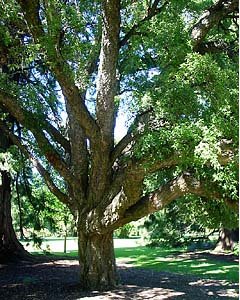- Cork Oak
Taxobox
name = Cork Oak
status = secure

image_width = 240px
image_caption = Cork Oak inChristchurch botanic gardens
regnum =Plant ae
divisio = Magnoliophyta
classis = Magnoliopsida
ordo =Fagales
familia =Fagaceae
genus = "Quercus"
sectio = "Cerris"
species = "Q. suber"
binomial = "Quercus suber"
binomial_authority = L.The Cork Oak ("Quercus suber") is a medium-sized,
evergreen oak tree in the section "Quercus" sect. "Cerris". It is native to southwestEurope and northwestAfrica .It grows to up to 20 m, although it is typically more stunted in its native environment. The leaves are 4 to 7 cm long, weakly lobed or coarsely toothed, dark green above, paler beneath, with the leaf margins often downcurved. The
acorn s are 2 to 3 cm long, in a deep cup fringed with elongated scales.The tree forms a thick, rugged and corky bark. Over time this bark can develop considerable thickness and this can be harvested every 10 to 12 years as cork. The harvesting of cork does not harm the tree and a new layer of cork regrows, making it a renewable resource. The tree is widely cultivated in
Spain ,Portugal ,Algeria ,Morocco ,France ,Italy andTunisia . Cork Oak forests cover approximately 25,000 square kilometres in those countries. Portugal accounts for 50% of the world cork harvest. Cork Oaks cannot legally be cut down in Portugal, except for forest management felling of old, unproductive trees.Cork Oaks live about 150 to 250 years. Virgin cork (or 'male' cork) is the first cork cut from generally 25 year old trees. Another 10 to 12 years is required for the second harvest, and a tree can be harvested twelve times in its lifetime. Cork harvesting is done entirely without machinery.
The European cork industry produces 340,000
tonne s of cork a year, with a value of €1.5 billion and employing 30,000 people.Wine corks represent 15% of cork usage by weight but 66% of revenues.Cork Oaks are sometimes planted as individual trees, providing a minor income to their owners. The tree is also sometimes cultivated for ornament. Hybrids with
Turkey Oak ("Quercus cerris") are regular, both in the wild in southwest Europe and in cultivation; the hybrid is known as Lucombe Oak "Quercus × hispanica".Some cork is also produced in eastern
Asia from the relatedChinese Cork Oak ("Quercus variabilis").Gallery
External links
* [http://www.realcork.org APCOR] – Associação Portuguesa de Cortiça (Portuguese Cork Association)
* [http://www.geographyinaction.co.uk/Assets/Photo_albums/One/pages/CorkOak1_jpg.html Photograph of cork oaks in Portugal]
Wikimedia Foundation. 2010.
